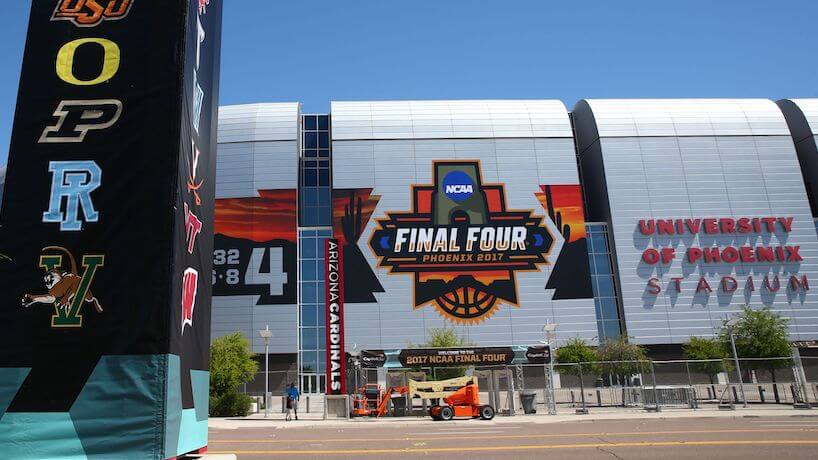The most recent NCAA men’s basketball tournament featured many of the key ingredients that make it a year-after-year American sports favorite: small programs challenging powerhouse universities, rising stars sinking buzzer beaters, and elated fans celebrating victories. However, this year’s competition included a never-been-done-before component, too. This marked the first time in history that Phoenix hosted the NCAA Men’s Final Four. Phoenix is no stranger to massive events — the city hosted Super Bowl XLIX in 2015 and the 2016 College Football Playoff National Championship — but the Final Four is a different animal. I caught up with AJ Altaras, director of national accounts at Visit Phoenix, who worked on the details of the event for three years, for some of her key takeaways once the madness of March ended in Arizona.
1) Be willing to be very flexible.
Every meeting professional understands the importance of making adjustments for last-minute changes — speaker cancellations, unexpected travel issues, and more. However, the Final Four’s structure is inherently more challenging. “One issue that is tough for any meeting professional to swallow is that you don’t know who your client is until shortly before arrival,” Altaras said. “Despite all the months of planning and preparation, you can’t apply any of it until you know which teams are walking in the door.”
Planning changes once the event begins, too. Altaras highlighted that Visit Phoenix collaborated closely with the NCAA on advising hotel properties once the games on Saturday finished. “As we moved through the weekend, we helped appropriate security to certain properties downtown as teams moved out and other fans moved in,” Altaras said. “We worked with the directors of security at hotels, the NCAA, and local law enforcement to make sure that players and family were safe and that crowds were under control.”
2) To increase the event’s impact, extend the invitation to those who don’t have tickets.
There were a lot of visitors in Phoenix to see the competition; in fact, the total attendance figure of 153,780 for the championship and semifinal games made it the second-biggest crowd in Final Four history. However, the crowd extended well beyond the walls of the University of Phoenix Stadium and kept the energy high in downtown Phoenix. Approximately 135,000 fans attended the free March Madness Music Festival, and more than 50,000 fans participated in the Final Four Fan Fest at the Phoenix Convention Center.
“We’ve been accustomed to big events during the Super Bowl and the College Football Championship, but there’s a big difference between hosting a Final Four and a one-off event,” Altaras said. “With four nights of festivities, we worked with the NCAA to help the entire community enjoy what was happening around them.”
SEE ALSO: Explore the Phoenix Convention Center
3) Count on the host destination’s community of volunteers.
As the fans were enjoying those events, many Phoenix residents were playing integral roles in making the ancillary events successful. With more than 3,600 volunteers donating their time and energy to the festivities, it’s clear that Phoenix has a community of residents who are proud to show off their city. “Phoenix is a destination that has very strong volunteer support,” Altaras said. “We have a database of locals who are interested in participating in the work to pull off these big events. They’re committed to making sure that visitors feel welcome in our city, and they’re thrilled to be involved when guests are arriving.”
SEE ALSO: Voluntourism Opportunities for Your Group in Phoenix
4) Know how to balance priorities.
In addition to more events for fans, Visit Phoenix was hosting another big event: the annual gathering of the National Association of Basketball Coaches. Co-located with the Final Four each year, the event unites coaches from Division I, II, and III to vote on legislation and network for potential hiring shifts during the off-season. “The NCAA focuses the entire event on the student-athletes who are competing,” Altaras said. “Many of them have worked their entire lives to play this game. So, our team worked to make sure that the experience exceeded expectations for the student-athletes while also responding to requests from high-profile guests to keep the NABC meeting flowing smoothly.”
5) What’s left behind matters as much as what happens during the event.
Phoenix stood in the spotlight for the entire weekend, but Altaras said that the NCAA was equally focused on leaving an enduring legacy in the city. With a contest called Read to the Final Four, the organization inspired 32,000 Arizona third-grade students to read more than six million minutes in the three months leading to the championship weekend. And one of the next rising basketball stars may already be training at the city’s Harmon Park, which received a $300,000 renovation from the NCAA Legacy Restorations Projects. “It’s great to know that the teams in town weren’t the only winners,” Altaras said. “Phoenix will continue to feel the impact of hosting the Final Four for years to come.”
Learn more about how the team at Visit Phoenix can make a difference for your next conference or meeting. If you are interested in booking your 2019 citywide convention in Phoenix, ask about Meet Your Million, an offer that includes up to one million hotel loyalty rewards points, waived attrition at participating hotels and more.
Sponsored by Visit Phoenix


